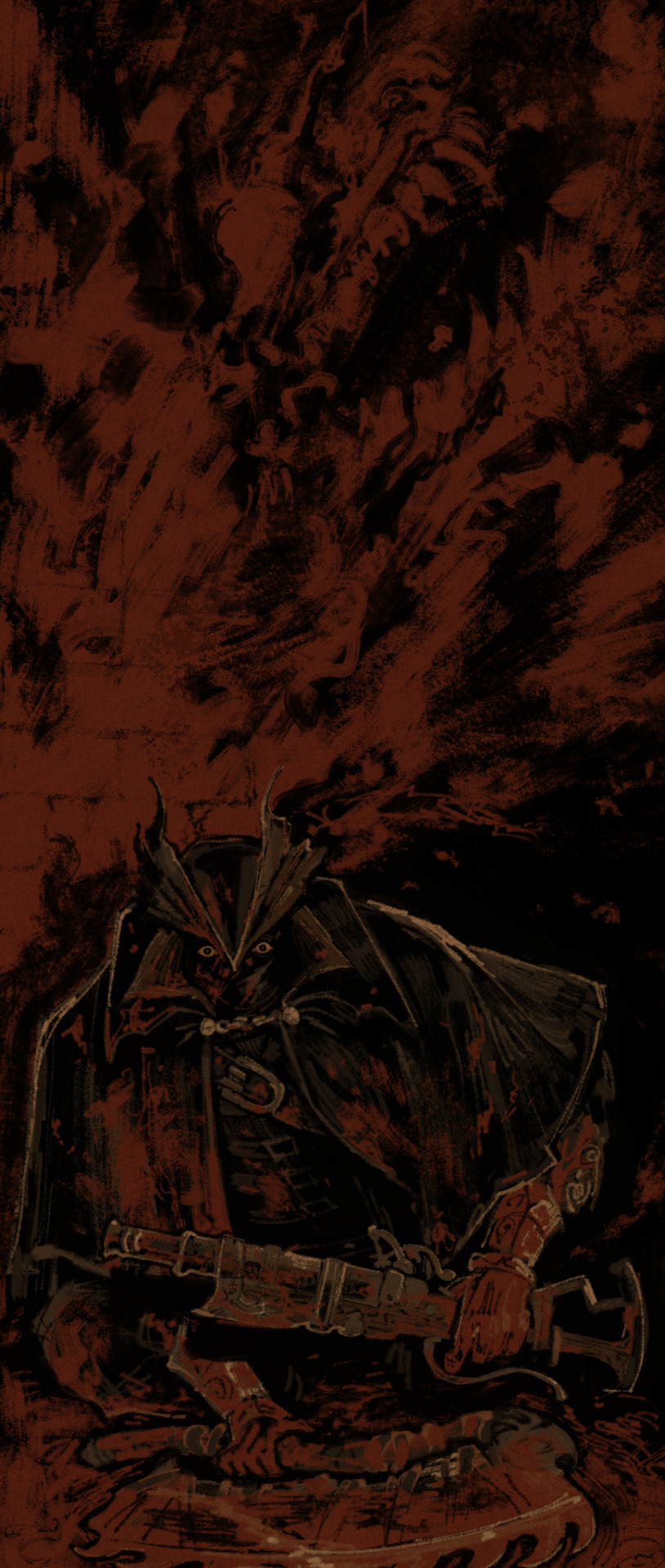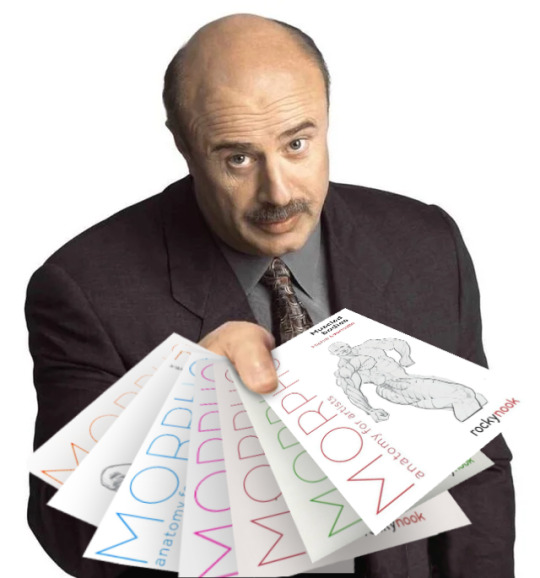25any/all schizophrenic system trying to keep creating Open dms! I need more writing/drawing buddies to motivate me
Don't wanna be here? Send us removal request.
Text
im not a pantser or a plotter but a secret third thing
the fact that i accidentally pushed the caps lock button while screenshotting my ms paint masterpiece

#creative writing#science fiction writing#fantasy writing#story writing#amatuer writer X#writing advice#writer things#writer struggles#writing memes#fiction writing#sciencefantasy
11 notes
·
View notes
Text

I drew him

2 notes
·
View notes
Text

2 notes
·
View notes
Text
Editing Your Own Novel

Questions to Consider
Character Development & Motivation
Are the goals and motivations of the protagonist clear?
Are the characters authentic and three dimensional?
Are the characters proactive about achieving their goals?
Are the relationships between the characters well-developed and believable?
Are the character’s voices distinct from one another, and consistent throughout?
Plot & Pacing
Are the stakes high enough to drive the tension throughout the narrative?
Are the plot twists believable, yet unexpected?
Do the characters react realistically to the events of the novel?
Do the events unfold naturally, or are there events that jar or confuse the reader?
Are there sections that lag or bore the reader?
Does every scene drive the story forward?
Are the hooks at the beginning and ends of each chapter effective?
Does the book start and end in the most appropriate places?
Is the story free of info-dumps that slow the action?
Setting
Is the reader provided with a clear sense of place/location?
Is the period of time, and the sense of time passing, clear throughout the manuscript?
Are there sections where there could be more (or less) description of setting?
Voice
Is the voice appropriate for the genre and target audience?
Is the point of view the most appropriate and effective for the story that unfolds?
Is the voice and tone consistent throughout the manuscript?
Is the voice fresh and engaging?
Source Writing References: Plot ⚜ Character ⚜ Worldbuilding
222 notes
·
View notes
Text
Isekai Writing Prompt

#writing prompt#writing#writers on tumblr#oc prompt#imagine your ocs#story prompt#story inspo#story ideas#creative writing prompt#creative writing ideas#promptsforthestrugglingauthor#science fiction#isekai#reincarnation#scifi military#writing ideas
5 notes
·
View notes
Text
Writing Notes: Coping Mechanisms
Researchers have identified over 400 different coping strategies and presented multiple classifications for healthy coping styles (Machado et al., 2020).
They can be viewed on the coping strategy wheel and have been divided into 5 broad styles.

Unhealthy coping, on the other hand, involves maladaptive responses and often leads to a cycle of increasing distress (Skinner et al., 2003).
Unhealthy coping mechanisms involve behaviors that provide short-term relief but may exacerbate distress in the long run.
Substance abuse, avoidance, self-harm, and negative self-talk are among the most common examples of unhelpful coping strategies (Klonsky, 2007; Skinner et al., 2003).

These strategies often impede emotional processing, worsen our stress, and hinder effective problem-solving. Unhealthy coping mechanisms can lead to a cycle of negative emotions, decreased self-esteem, ill health, and even physical harm (Suls & Fletcher, 1985; Zuckerman, 1999).
Coping is an essential psychological process for managing stress and our emotions (Folkman & Moskowitz, 2004).
Coping consists of our “thoughts and behaviors mobilized to manage internal and external stressful situations” (Algorani & Gupta, 2021, p. 1).
Coping mechanisms are psychological strategies that can entail thoughts or behaviors designed to manage stress, adversity, and emotional challenges.
Healthy coping involves adaptive strategies that foster our long-term psychological well-being, while unhealthy coping encompasses maladaptive approaches that can lead to negative outcomes.
Healthy coping strategies, such as relaxation, seeking support from our loved ones, and positive reframing of unhelpful cognitions, are designed to foster resilience (Compas et al., 2001).
Such coping promotes emotional regulation, enhances problem-solving skills, and cultivates a sense of self-efficacy and learning. In that way, it contributes to our long-term wellbeing and thriving.
Source ⚜ More: Writing Notes & References ⚜ Writing Resources PDFs
397 notes
·
View notes
Text



Bringing drip to the Trench Crusade, it's the French again !
1K notes
·
View notes
Text

another character sketch for the Thorn Crowndom setting
#drawing#art practice#artwork#drawings#sciencefantasy#darkfantasy#mangadrawing#sketch#armorknight#knight drawing#armor design#scifi military
1 note
·
View note
Text
Words for Skin Tone | How to Describe Skin Color
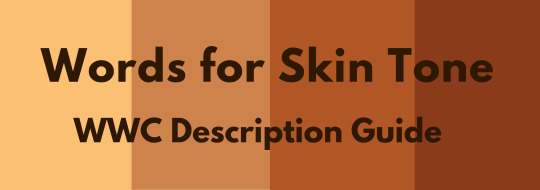
We discussed the issues describing People of Color by means of food in Part I of this guide, which brought rise to even more questions, mostly along the lines of “So, if food’s not an option, what can I use?” Well, I was just getting to that!
This final portion focuses on describing skin tone, with photo and passage examples provided throughout. I hope to cover everything from the use of straight-forward description to the more creatively-inclined, keeping in mind the questions we’ve received on this topic.
Standard Description
Basic Colors

Pictured above: Black, Brown, Beige, White, Pink.
“She had brown skin.”
This is a perfectly fine description that, while not providing the most detail, works well and will never become cliché.
Describing characters’ skin as simply brown or beige works on its own, though it’s not particularly telling just from the range in brown alone.
Complex Colors
These are more rarely used words that actually “mean” their color. Some of these have multiple meanings, so you’ll want to look into those to determine what other associations a word might have.

Pictured above: Umber, Sepia, Ochre, Russet, Terra-cotta, Gold, Tawny, Taupe, Khaki, Fawn.
Complex colors work well alone, though often pair well with a basic color in regards to narrowing down shade/tone.
For example: Golden brown, russet brown, tawny beige…
As some of these are on the “rare” side, sliding in a definition of the word within the sentence itself may help readers who are unfamiliar with the term visualize the color without seeking a dictionary.
“He was tall and slim, his skin a russet, reddish-brown.”
Comparisons to familiar colors or visuals are also helpful:
“His skin was an ochre color, much like the mellow-brown light that bathed the forest.”
Modifiers
Modifiers, often adjectives, make partial changes to a word.The following words are descriptors in reference to skin tone.
Dark - Deep - Rich - Cool
Warm - Medium - Tan
Fair - Light - Pale
Rich Black, Dark brown, Warm beige, Pale pink…
If you’re looking to get more specific than “brown,” modifiers narrow down shade further.
Keep in mind that these modifiers are not exactly colors.
As an already brown-skinned person, I get tan from a lot of sun and resultingly become a darker, deeper brown. I turn a pale, more yellow-brown in the winter.
While best used in combination with a color, I suppose words like “tan” “fair” and “light” do work alone; just note that tan is less likely to be taken for “naturally tan” and much more likely a tanned White person.
Calling someone “dark” as description on its own is offensive to some and also ambiguous. (See: Describing Skin as Dark)
Undertones
Undertones are the colors beneath the skin, seeing as skin isn’t just one even color but has more subdued tones within the dominating palette.

pictured above: warm / earth undertones: yellow, golden, copper, olive, bronze, orange, orange-red, coral | cool / jewel undertones: pink, red, blue, blue-red, rose, magenta, sapphire, silver.
Mentioning the undertones within a character’s skin is an even more precise way to denote skin tone.
As shown, there’s a difference between say, brown skin with warm orange-red undertones (Kelly Rowland) and brown skin with cool, jewel undertones (Rutina Wesley).
“A dazzling smile revealed the bronze glow at her cheeks.”
“He always looked as if he’d ran a mile, a constant tinge of pink under his tawny skin.”
Standard Description Passage
“Farah’s skin, always fawn, had burned and freckled under the summer’s sun. Even at the cusp of autumn, an uneven tan clung to her skin like burrs. So unlike the smooth, red-brown ochre of her mother, which the sun had richened to a blessing.”
-From my story “Where Summer Ends” featured in Strange Little Girls
Here the state of skin also gives insight on character.
Note my use of “fawn” in regards to multiple meaning and association. While fawn is a color, it’s also a small, timid deer, which describes this very traumatized character of mine perfectly.
Though I use standard descriptions of skin tone more in my writing, at the same time I’m no stranger to creative descriptions, and do enjoy the occasional artsy detail of a character.
Creative Description
Whether compared to night-cast rivers or day’s first light…I actually enjoy seeing Characters of Colors dressed in artful detail.
I’ve read loads of descriptions in my day of white characters and their “smooth rose-tinged ivory skin”, while the PoC, if there, are reduced to something from a candy bowl or a Starbucks drink, so to actually read of PoC described in lavish detail can be somewhat of a treat.
Still, be mindful when you get creative with your character descriptions. Too many frills can become purple-prose-like, so do what feels right for your writing when and where. Not every character or scene warrants a creative description, either. Especially if they’re not even a secondary character.
Using a combination of color descriptions from standard to creative is probably a better method than straight creative. But again, do what’s good for your tale.
Natural Settings - Sky
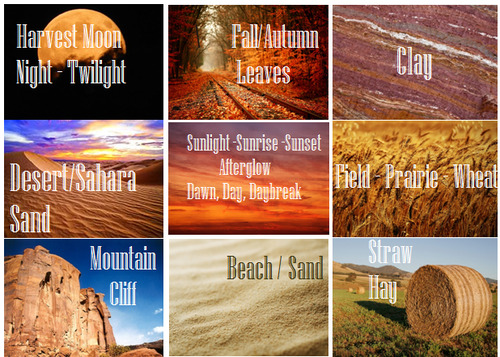
Pictured above: Harvest Moon -Twilight, Fall/Autumn Leaves, Clay, Desert/Sahara, Sunlight - Sunrise - Sunset - Afterglow - Dawn- Day- Daybreak, Field - Prairie - Wheat, Mountain/Cliff, Beach/Sand/Straw/Hay.
Now before you run off to compare your heroine’s skin to the harvest moon or a cliff side, think about the associations to your words.
When I think cliff, I think of jagged, perilous, rough. I hear sand and picture grainy, yet smooth. Calm. mellow.
So consider your character and what you see fit to compare them to.
Also consider whose perspective you’re describing them from. Someone describing a person they revere or admire may have a more pleasant, loftier description than someone who can’t stand the person.
“Her face was like the fire-gold glow of dawn, lifting my gaze, drawing me in.”
“She had a sandy complexion, smooth and tawny.”
Even creative descriptions tend to draw help from your standard words.
Flowers
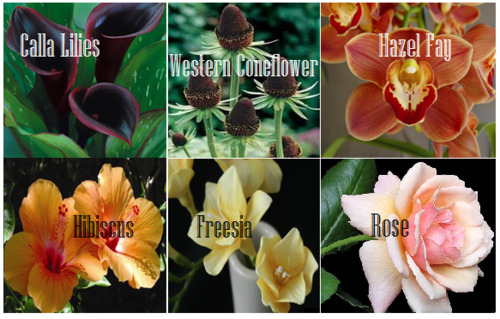
Pictured above: Calla lilies, Western Coneflower, Hazel Fay, Hibiscus, Freesia, Rose
It was a bit difficult to find flowers to my liking that didn’t have a 20 character name or wasn’t called something like “chocolate silk” so these are the finalists.
You’ll definitely want to avoid purple-prose here.
Also be aware of flowers that most might’ve never heard of. Roses are easy, as most know the look and coloring(s) of this plant. But Western coneflowers? Calla lilies? Maybe not so much.
“He entered the cottage in a huff, cheeks a blushing brown like the flowers Nana planted right under my window. Hazel Fay she called them, was it?”
Assorted Plants & Nature

Pictured above: Cattails, Seashell, Driftwood, Pinecone, Acorn, Amber
These ones are kinda odd. Perhaps because I’ve never seen these in comparison to skin tone, With the exception of amber.
At least they’re common enough that most may have an idea what you’re talking about at the mention of “pinecone."
I suggest reading out your sentences aloud to get a better feel of how it’ll sounds.
"Auburn hair swept past pointed ears, set around a face like an acorn both in shape and shade.”
I pictured some tree-dwelling being or person from a fantasy world in this example, which makes the comparison more appropriate.
I don’t suggest using a comparison just “cuz you can” but actually being thoughtful about what you’re comparing your character to and how it applies to your character and/or setting.
Wood

Pictured above: Mahogany, Walnut, Chestnut, Golden Oak, Ash
Wood can be an iffy description for skin tone. Not only due to several of them having “foody” terminology within their names, but again, associations.
Some people would prefer not to compare/be compared to wood at all, so get opinions, try it aloud, and make sure it’s appropriate to the character if you do use it.
“The old warlock’s skin was a deep shade of mahogany, his stare serious and firm as it held mine.”
Metals

Pictured above: Platinum, Copper, Brass, Gold, Bronze
Copper skin, brass-colored skin, golden skin…
I’ve even heard variations of these used before by comparison to an object of the same properties/coloring, such as penny for copper.
These also work well with modifiers.
“The dress of fine white silks popped against the deep bronze of her skin.”
Gemstones - Minerals
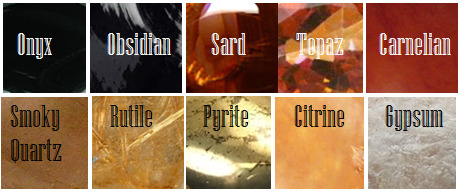
Pictured above: Onyx, Obsidian, Sard, Topaz, Carnelian, Smoky Quartz, Rutile, Pyrite, Citrine, Gypsum
These are trickier to use. As with some complex colors, the writer will have to get us to understand what most of these look like.
If you use these, or any more rare description, consider if it actually “fits” the book or scene.
Even if you’re able to get us to picture what “rutile” looks like, why are you using this description as opposed to something else? Have that answer for yourself.
“His skin reminded her of the topaz ring her father wore at his finger, a gleaming stone of brown, mellow facades.”
Physical Description
Physical character description can be more than skin tone.
Show us hair, eyes, noses, mouth, hands…body posture, body shape, skin texture… though not necessarily all of those nor at once.
Describing features also helps indicate race, especially if your character has some traits common within the race they are, such as afro hair to a Black character.
How comprehensive you decide to get is up to you. I wouldn’t overdo it and get specific to every mole and birthmark. Noting defining characteristics is good, though, like slightly spaced front teeth, curls that stay flopping in their face, hands freckled with sunspots…
General Tips
Indicate Race Early: I suggest indicators of race be made at the earliest convenience within the writing, with more hints threaded throughout here and there.
Get Creative On Your Own: Obviously, I couldn’t cover every proper color or comparison in which has been “approved” to use for your characters’ skin color, so it’s up to you to use discretion when seeking other ways and shades to describe skin tone.
Skin Color May Not Be Enough: Describing skin tone isn’t always enough to indicate someone’s ethnicity. As timeless cases with readers equating brown to “dark white” or something, more indicators of race may be needed.
Describe White characters and PoC Alike: You should describe the race and/or skin tone of your white characters just as you do your Characters of Color. If you don’t, you risk implying that White is the default human being and PoC are the “Other”).
PSA: Don’t use “Colored.” Based on some asks we’ve received using this word, I’d like to say that unless you or your character is a racist grandmama from the 1960s, do not call People of Color “colored” please.
Not Sure Where to Start? You really can’t go wrong using basic colors for your skin descriptions. It’s actually what many people prefer and works best for most writing. Personally, I tend to describe my characters using a combo of basic colors + modifiers, with mentions of undertones at times. I do like to veer into more creative descriptions on occasion.
Want some alternatives to “skin” or “skin color”? Try: Appearance, blend, blush, cast, coloring, complexion, flush, glow, hue, overtone, palette, pigmentation, rinse, shade, sheen, spectrum, tinge, tint, tone, undertone, value, wash.
Skin Tone Resources
List of Color Names
The Color Thesaurus
Skin Undertone & Color Matching
Tips and Words on Describing Skin
Photos: Undertones Described (Modifiers included)
Online Thesaurus (try colors, such as “red” & “brown”)
Don’t Call me Pastries: Creative Skin Tones w/ pics I
Writing & Description Guides
WWC Featured Description Posts
WWC Guide: Words to Describe Hair
Writing with Color: Description & Skin Color Tags
7 Offensive Mistakes Well-intentioned Writers Make
I tried to be as comprehensive as possible with this guide, but if you have a question regarding describing skin color that hasn’t been answered within part I or II of this guide, or have more questions after reading this post, feel free to ask!
~ Mod Colette
169K notes
·
View notes
Text
The 7 Faces of Friendship: Character Types to Include in Your Book’s Friend Group
Having a balance of different personas helps create a comprehensive cast for your novels. To get started, here are the 7 main friend personas to consider:
1. The Leader
Description:
The leader is the driving force behind the group. They are often assertive, confident, and willing to take charge in various situations. This person is typically seen as a decision-maker, guiding the group toward plans, activities, or goals.
Traits:
Charismatic: Naturally draws people in and inspires others.
Decisive: Quick to make decisions, often with a clear vision in mind.
Responsible: Takes ownership of the group's well-being and direction.
Role in the Group:
The leader often organises outings, mediates conflicts, and keeps the group focused on shared goals. They are instrumental in making plans and ensuring that everyone feels included.
2. The Caregiver
Description:
The caregiver is the heart of the friend group, always looking out for others. This person is empathetic, nurturing, and willing to lend a helping hand or an understanding ear.
Traits:
Compassionate: Deeply cares for the feelings and well-being of others.
Supportive: Always ready to offer encouragement or assistance.
Attentive: Notices when someone is feeling down or needs help.
Role in the Group:
The caregiver often acts as the emotional glue, fostering connections and ensuring everyone feels valued. They are typically the ones organising gatherings to celebrate friends or supporting them through tough times.
3. The Comedian
Description:
The comedian is the life of the party, always ready with a joke or a funny story. This character brings humour and lightness to the group, helping to relieve tension and elevate the mood.
Traits:
Witty: Quick with humour and often makes clever observations.
Playful: Approaches life with a sense of fun and spontaneity.
Positive: Maintains an optimistic outlook, even in challenging situations.
Role in the Group:
The comedian keeps the atmosphere lively, ensuring that laughter is a common thread in the group. They often defuse tense situations with humour and help create cherished memories through fun experiences.
4. The Adventurer
Description:
The adventurer thrives on new experiences and excitement. This character is always seeking thrills, whether that’s trying out a new restaurant, going on spontaneous trips, or participating in extreme sports.
Traits:
Daring: Enjoys taking risks and stepping outside of their comfort zone.
Curious: Eager to explore new ideas, places, and experiences.
Energetic: Brings enthusiasm to the group, often encouraging others to join in.
Role in the Group:
The adventurer often leads the charge for new experiences, pushing the group to try things they might not have considered. They inspire others to embrace spontaneity and explore the world together. Often contradicts the leader.
5. The Intellectual
Description:
The intellectual is the thinker of the group, often delving into deep conversations and pondering life's big questions. This character values knowledge and is well-read, informed, and curious about various topics.
Traits:
Analytical: Enjoys breaking down complex ideas and analysing situations.
Inquisitive: Asks questions and seeks to understand the world.
Articulate: Communicates thoughts clearly and effectively.
Role in the Group:
The intellectual can help stimulate meaningful conversations, adding depth to the group's interactions. More of a quiet yet important presence. They help get the Adventurer out of trouble, and are likely found bantering with the Comedian from time to time.
6. The Connector
Description:
The connector is the social butterfly of the group, adept at bringing people together and building relationships. This character thrives on interaction and often knows everyone’s stories, interests, and backgrounds.
Traits:
Sociable: Enjoys meeting new people and introducing friends to one another.
Empathetic: Understands social dynamics and helps others feel comfortable.
Resourceful: Knows where to go for recommendations and suggestions.
Role in the Group:
The connector enriches the group by fostering relationships and creating opportunities for social gatherings. They often organise events and help deepen bonds within the friend circle. They are generally close to the Caregiven and the Leader’s partner/close friend. They help the Leader and Intellectual settle on ideas that are both fun and functional thus appeasing to the whole group.
7. The Realist
Description:
The realist is grounded and practical, providing a balanced perspective within the friend group. This character approaches situations with a level-headed attitude and often focuses on the facts at hand.
Note: While the intellectual is an inherently smart person, the realist is the apathetic and logical force of the group. They don’t have to necessarily be smart but are insightful.
Traits:
Pragmatic: Values practicality and often offers sensible solutions.
Sceptical: Questions overly optimistic or unrealistic plans.
Honest: Tends to speak their mind, even when the truth is uncomfortable.
Role in the Group:
The realist often acts as a counterbalance to more idealistic characters, helping the group assess risks and make informed decisions. They provide a sense of stability, ensuring that plans are not just fun but also feasible.
Looking For More Writing Tips And Tricks?
Check out the rest of Quillology with Haya; a blog dedicated to writing and publishing tips for authors! Instagram Tiktok
4K notes
·
View notes
Text
The Fourth Man from the Fire

another character design of a religious warrior for my story setting the Thorn Crowndom
#fighter#magic#characterdesign#conceptart#drawing#lineart#oc#priest#rpgcharacter#sciencefictionfantasy#symbolism#warrior#worldbuilding#conceptartcharacter#originalsetting#art practice#drawings#artwork#sciencefantasy#scifi art#military
3 notes
·
View notes
Text
Glowing Fella Invasion

#horror#monster#creepy#ghost#spooky#abandoned#creature#undead#dark#invasion#mixedmedia#mixedmediaart#night#sciencefiction#drawing#art practice#artwork#drawings#scifi art#darkfantasy#creature design
7 notes
·
View notes
Text
Writing Notes & References
Alchemy ⚜ Antidote to Anxiety ⚜ Attachment ⚜ Autopsy
Art: Elements ⚜ Principles ⚜ Photographs ⚜ Watercolour
Bruises ⚜ Caffeine ⚜ Color Blindness ⚜ Cruise Ships
Children ⚜ Children's Dialogue ⚜ Childhood Bilingualism
Dangerousness ⚜ Drowning ⚜ Dystopia ⚜ Dystopian World
Culture ⚜ Culture Shock ⚜ Ethnocentrism & Cultural Relativism
Emotions: Anger ⚜ Fear ⚜ Happiness ⚜ Sadness
Emotional Intelligence ⚜ Genius (Giftedness) ⚜ Quirks
Facial Expressions ⚜ Laughter & Humour ⚜ Swearing & Taboo
Fantasy Creatures ⚜ Fantasy World Building
Generations ⚜ Literary & Character Tropes
Fight Scenes ⚜ Kill Adverbs
Food: Cooking Basics ⚜ Herbs & Spices ⚜ Sauces ⚜ Wine-tasting ⚜ Aphrodisiacs ⚜ List of Aphrodisiacs ⚜ Food History ⚜ Cocktails ⚜ Literary & Hollywood Cocktails ⚜ Liqueurs
Genre: Crime ⚜ Horror ⚜ Fantasy ⚜ Speculative Biology
Hate ⚜ Love ⚜ Kinds of Love ⚜ The Physiology of Love
How to Write: Food ⚜ Colours ⚜ Drunkenness
Jargon ⚜ Logical Fallacies ⚜ Memory ⚜ Memoir
Magic: Magic System ⚜ 10 Uncommon ⚜ How to Choose
Moon: Part 1 2 ⚜ Related Words
Mystical Items & Objects ⚜ Talisman ⚜ Relics ⚜ Poison
Pain ⚜ Pain & Violence ⚜ Poison Ivy & Poison Oak
Realistic Injuries 1 2 ⚜ Rejection ⚜ Structural Issues ⚜ Villains
Symbolism: Colors ⚜ Food ⚜ Numbers ⚜ Storms
Thinking ⚜ Thinking Styles ⚜ Thought Distortions
Terms of Endearment ⚜ Ways of Saying "No" ⚜ Yoga
Compilations: Plot ⚜ Character ⚜ Worldbuilding ⚜ For Poets ⚜ Tips & Advice
all posts are queued. will update this every few weeks/months. send questions or requests here.
15K notes
·
View notes
Text

why can't I just be a millionaire's eccentric author and write all their crazy novels on commission
#darkfantasy#story writing#writing#puppypilled#creative writing#fantasy writing#science fantasy#stoner
0 notes
